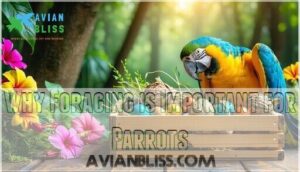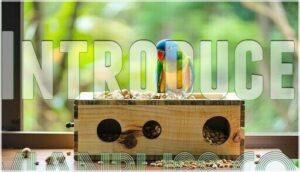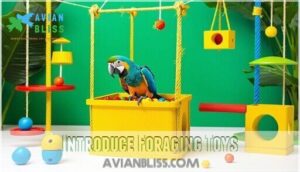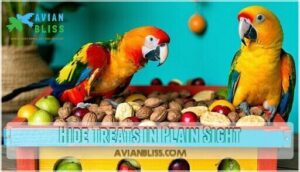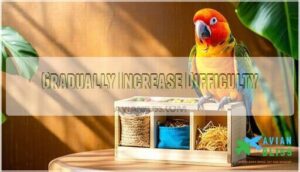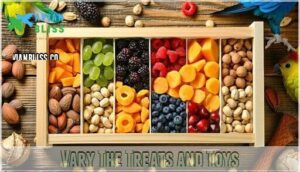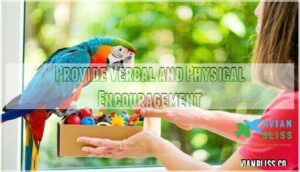This site is supported by our readers. We may earn a commission, at no cost to you, if you purchase through links.
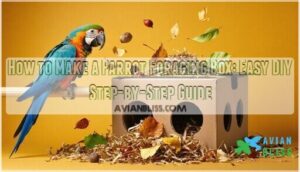
Cut holes slightly larger than your parrot’s head, then stuff with shredded paper, dried leaves, or crumpled tissue.
Hide treats like nuts, seeds, or dried fruit inside the materials, and place the box near your bird’s favorite perch and let them discover it naturally.
Start simple – if they’re hesitant, leave some treats visible at first, as the key is making your feathered friend work for their reward, just like they would in the wild, which is tapping into their deepest instincts while keeping those clever minds sharp, and providing them with busy work.
Table Of Contents
- Key Takeaways
- What is a Parrot Foraging Box?
- Why Foraging is Important for Parrots
- How to Make a Parrot Foraging Box
- How to Teach Your Parrot to Start Foraging?
- Frequently Asked Questions (FAQs)
- How to make a parrot foraging box?
- Do parrots need a box?
- How to make a bird foraging box?
- How big should a parrot box be?
- How do you keep a parrot in a cage?
- How do you make a foraging toy?
- What is a foraging box for a parrot?
- Do parrots eat foraging boxes?
- What do I need for a parrot foraging box?
- How do you get a parrot to eat a box?
- Conclusion
Key Takeaways
- You’ll need basic household items like a clean cardboard box, scissors, and bird-safe treats – no expensive materials required to create effective mental stimulation for your parrot.
- Cut holes slightly larger than your parrot’s head and stuff the box with shredded paper or dried leaves, hiding treats inside to mimic their natural foraging instincts.
- Start simple by leaving some treats visible at first, then gradually increase difficulty as your parrot becomes comfortable – patience beats rushing the learning process.
- Place the foraging box near your bird’s favorite perch and rotate contents regularly to prevent boredom while providing up to 70% of the mental engagement they’d get in the wild.
What is a Parrot Foraging Box?
A parrot foraging box is basically your bird’s puzzle feeder—a container designed with compartments and openings that challenges your parrot to work for their treats.
These DIY foraging boxes tap into your bird’s instinct to search and explore, just like they’d in the wild.
Parrot enrichment through foraging toys provides vital bird stimulation while supporting natural behavior.
The box designs can range from simple cardboard containers to complex multi-level systems.
Think of it as turning mealtime into an engaging treasure hunt that keeps your feathered friend mentally sharp and physically active.
Providing a stimulating environment with proper enrichment techniques is essential for parrot wellbeing.
Why Foraging is Important for Parrots
Understanding your parrot’s needs goes beyond basic care.
Wild parrots spend up to 70% of their waking hours searching for food, making foraging a biological necessity rather than optional entertainment.
Foraging transforms captive birds into active problem-solvers, mimicking their wild instincts for mental and physical wellbeing
Here’s why foraging transforms your bird’s daily routine:
- Mental Stimulation: Problem-solving activities prevent cognitive decline and boost brain health through increased dopamine production
- Natural Behavior: Fulfills instinctual needs to explore and manipulate objects, reducing psychological distress
- Physical Exercise: Active searching maintains muscle tone and prevents obesity-related health complications
- Behavioral Benefits: Reduces feather plucking by up to 80% and decreases stress-related screaming
Parrot nutrition improves when birds work for meals.
Bird wellness depends on mental stimulation that mirrors natural behavior patterns.
Foraging benefits include enhanced focus and trainability.
Monitoring bird health signs is essential for identifying potential issues early on.
How to Make a Parrot Foraging Box
Creating your own foraging box is simpler than you might think and requires just basic household materials.
You’ll gather supplies, assemble the box with hidden compartments, and introduce it to your parrot gradually.
Gather Materials
Gathering the right materials sets you up for success. You’ll need cardboard boxes (cereal or shipping boxes work perfectly), natural fibers like sisal rope, parrot toys such as wooden blocks and bells, plus bird treats like nuts and dried fruits.
Don’t forget scissors and a hole punch for creating openings. When selecting a base structure, consider using cardboard box alternatives to provide variety in your parrot’s foraging experience.
| Material Category | Specific Items | Safety Notes |
|---|---|---|
| Base Structure | Cardboard boxes, wooden boxes | Remove staples, tape, sharp edges |
| Foraging Materials | Shredded paper, bamboo sticks, coffee filters | Avoid ink, chemicals, treated materials |
| Enrichment Items | Wooden blocks, bells, plastic rings | Make certain parrot-safe, non-toxic construction |
| Food Rewards | Nuts, dried fruits, bird pellets | Use unsalted, parrot-appropriate varieties |
| Tools | Scissors, hole punch, utility knife | Handle carefully during construction |
Assemble
Now comes the fun part – turning your materials into a parrot foraging box that’ll keep your bird busy for hours. Select a box that matches your parrot’s size perfectly. You don’t want something so large they feel lost inside, or so cramped they can’t maneuver comfortably.
Safety first: strip away all tape, staples, and sharp edges that could harm your feathered friend. Material selection matters here – verify everything’s bird-safe before proceeding with foraging box construction.
Time for creative box design. Using scissors or a utility knife, create openings of varying sizes across the sides and top. Think of it as designing a puzzle – each hole should challenge your parrot without causing frustration. Small holes work great for pellets, while larger openings accommodate nuts or toy assembly components.
This customization approach transforms a simple container into an engaging foraging tray. The key lies in balancing accessibility with challenge. Your DIY parrot foraging toys should intrigue without overwhelming, creating the perfect foundation for mental stimulation and natural foraging behaviors. Understanding parrot foraging techniques is essential for creating an effective foraging box.
Introduce
Your parrot foraging box DIY project reaches its most pivotal phase during the introduction stage. Initial placement determines success—position the box in a familiar area near your bird’s favorite perch when they’re calm and alert.
Smart placement in familiar territory sets the stage for foraging success
Start simple by making treats visible and easily accessible. This creates positive associations with the new enrichment tool. Your parrot acclimation process should progress gradually—watch their comfort level and adjust accordingly.
Here’s your systematic introduction approach:
- Place the box during calm periods to reduce stress and encourage natural curiosity
- Use high-value treats initially like nuts or seeds to motivate investigation
- Monitor interaction levels daily to gauge readiness for increased complexity
- Establish consistent timing for foraging routine development
Toy rotation every few days maintains novelty. Box refill with varied contents prevents boredom. Remember, parrot foraging techniques develop through repetition—patience yields better results than rushing the process. Providing a stimulating environment is essential for promoting healthy parrot behavior and preventing boredom.
How to Teach Your Parrot to Start Foraging?
Teaching your parrot to forage requires patience and gradual introduction to new activities. Start with simple foraging toys and slowly build your bird’s confidence through positive reinforcement and consistent practice.
Introduce Foraging Toys
With your foraging box complete, introducing parrot foraging toys becomes your next step.
Begin with simple, beginner-friendly toys featuring easy-access compartments. These DIY parrot foraging toys should offer minimal challenge initially, allowing your bird to associate the activity with positive rewards.
Toy rotation keeps interest high while building confidence. Choose bird enrichment ideas that match your parrot’s size and temperament for maximum parrot stimulation.
Providing a stimulating environment with proper parrot enrichment activities is vital for their cognitive development and emotional wellbeing.
Hide Treats in Plain Sight
Place treats directly on your parrot foraging box surface where they’re easily visible.
This treat placement creates positive associations with bird puzzle toys. Your bird will quickly connect the toy with rewards, making future foraging techniques more successful.
Visual cues from exposed treats encourage initial exploration, building confidence before advancing to more challenging parrot foraging toys.
Gradually Increase Difficulty
Once you’ve successfully established your parrot’s interest in visible treats, it’s time to amp up the challenge levels and introduce more complex foraging scenarios.
This progressive approach prevents frustration while building your bird’s confidence and problem-solving skills.
Incremental changes to puzzle complexity extend engagement time by up to 40% in adult parrots, making this step vital for maintaining long-term interest in your parrot foraging box design.
- Compartment Concealment: Hide treats inside deeper compartments or beneath foraging box materials like shredded paper or coconut fiber, requiring your parrot to dig and explore
- Layered Puzzles: Add removable lids, sliding panels, or nested boxes that demand sequential problem-solving to access rewards
- Texture Challenges: Incorporate different foraging box complexity elements like wrapped treats in paper or nuts tucked inside small fabric pouches
Weekly adjustments to treat hiding locations and puzzle complexity maintain ideal cognitive stimulation.
This gradual progression from simple to advanced foraging box difficulty levels keeps your parrot engaged while developing natural foraging behaviors essential for mental health.
Vary The Treats and Toys
Rotating treats keeps your parrot mentally sharp and prevents boredom.
Mix nuts, dried fruits, and bird pellets weekly for ideal parrot enrichment.
Switch between shreddable, puzzle, and mechanical parrot foraging toys to challenge different skills.
This toy variety mimics wild foraging experiences, maintaining interest in your DIY bird toys and reward systems longer.
Providing a parrot foraging toy can help stimulate their natural behavior and problem-solving abilities, which is essential for a parrot’s well-being.
Provide Verbal and Physical Encouragement
Beyond simply offering treats, your encouragement becomes the bridge between confusion and confidence for your parrot.
Positive reinforcement through behavioral support transforms hesitant birds into enthusiastic foragers. Research shows that verbal encouragement leads to faster learning and stronger human-animal bonds during interactive training sessions.
Here are three essential encouragement techniques for your parrot foraging box:
- Verbal praise: Use consistent phrases like "good bird" or "well done" when they interact with foraging toys. This reward system creates positive associations with mental stimulation activities.
- Physical affection: Offer gentle head scratches or light feather ruffles as immediate rewards. Parrots respond strongly to this tactile reinforcement during bird foraging techniques training.
- Patient guidance: Provide gentle physical cues like tapping the box or demonstrating treat retrieval. This hands-on approach increases object interaction by nearly 50% according to behavioral studies.
Consistent encouragement strengthens trust while maintaining their natural curiosity about foraging challenges.
Frequently Asked Questions (FAQs)
How to make a parrot foraging box?
Select a sturdy cardboard box and remove tape or staples.
Cut access holes of varying sizes. Fill with shredded paper, natural materials, and hidden treats.
Customize difficulty based on your parrot’s experience level.
Do parrots need a box?
Parrots don’t strictly need boxes, but they’re incredibly beneficial. Foraging boxes provide mental stimulation, reduce boredom-related behaviors like feather plucking, and satisfy their natural instinct to search for food.
How to make a bird foraging box?
Like crafting a treasure chest for your feathered explorer, building a foraging box transforms mealtime into an adventure.
Start with a sturdy cardboard box, cutting various-sized holes throughout.
Fill it with shredded paper and hide treats inside compartments, creating layers of discovery that’ll keep your bird mentally stimulated.
How big should a parrot box be?
Choose a box that’s roughly twice your parrot’s wingspan in width and deep enough for comfortable movement.
Cockatiels need 8-12 inches, while larger parrots like macaws require 18-24 inches for an ideal foraging experience.
How do you keep a parrot in a cage?
Trust becomes the invisible cage when you provide a secure, spacious enclosure with proper perches, toys, food, water, and daily interaction.
You’re not imprisoning—you’re creating a safe haven where your feathered companion thrives while maintaining their wild spirit through enrichment activities.
How do you make a foraging toy?
Take a cardboard box and cut holes of varying sizes.
Fill it with shredded paper, then hide treats inside.
Your parrot will work to find the rewards, mimicking natural foraging behaviors.
What is a foraging box for a parrot?
Picture yourself opening a treasure chest filled with hidden delights—that’s exactly what a foraging box offers your feathered friend.
It’s a cardboard or wooden container stuffed with safe materials and treats, encouraging your parrot’s natural instinct to search and work for food, which is a natural part of their behavior.
Do parrots eat foraging boxes?
Parrots don’t typically eat foraging boxes, but they’ll chew and shred the cardboard during exploration.
You should use bird-safe materials and monitor your parrot to prevent excessive consumption of non-food items.
What do I need for a parrot foraging box?
You’ll need a sturdy cardboard box, bird-safe treats like nuts or dried fruits, natural fillers such as shredded paper or coconut fiber, and scissors to create access holes for exploration.
How do you get a parrot to eat a box?
Gradually introduce treats inside the cardboard box, starting with easily visible rewards. Show your parrot how to access food by demonstrating with your hands, then increase difficulty over time.
Conclusion
Despite what you might think, creating a parrot foraging box won’t take hours of craft time or expensive materials.
You can build an effective foraging solution in minutes using basic household items.
Learning how to make a parrot foraging box transforms mealtime into mental stimulation.
Your feathered companion will thank you for the enrichment that mirrors their natural behaviors.
Remember to supervise initial use and replace worn materials regularly.
This simple DIY project keeps intelligent birds engaged while promoting healthy foraging instincts.
- https://www.pigeonrescue.org/2018/09/11/how-to-catch-a-pigeon-or-dove-in-need-of-rescue/
- https://parrotwizard.com/Foraging_Box/
- https://www.royalbirdcompany.com/parrot-nest-box.htm
- https://www.thevetshed.com.au/blog/enriching-the-life-of-your-pet-bird/4427
- https://bonkabirdtoys.com/blogs/default-blog/why-rotating-bird-toys-is-essential-for-enrichment

